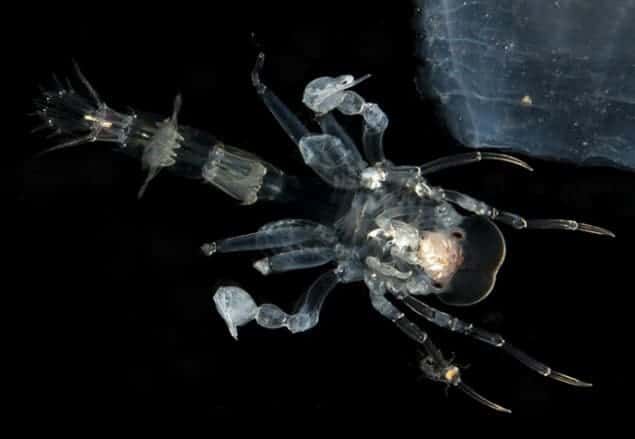
A group of small crustaceans that live in the twilight zone of the open ocean are coated in nanospheres that reduce the amount of light the crustaceans reflect, biologists in the US have discovered. The spheres, which are smaller than the wavelength of visible light, appear to be bacteria. The researchers believe the coating may help hide the transparent creatures from predators with bioluminescent searchlights.
Hyperiids are a suborder of more than 200 species of marine crustaceans. They inhabit the pelagic zone of the open ocean, from the surface to depths of around 4000 m. The featureless habitat of this twilight zone offers few places to hide from predators, so many of its denizens – including hyperliids – have transparent bodies as a form of camouflage. In the ambient ocean light they are almost invisible.
However, many of the local predator species, such as dragonfish, squid and lanternfish, have bioluminescent searchlights to help them find prey. As these creatures scan their light through the water they can locate these “invisible” animals by the light that reflects off their body surfaces. Such reflections are a particular issue for hard-shelled crustaceans such as hyperiids, because there is a large gradient between the refractive index of their chitin shells and that of seawater – something that results in relatively large amounts of reflection.
Altered refractive index
Researchers at Sönke Johnsen’s sensory biology lab at Duke University, in North Carolina, hypothesized that such hard-shelled creatures would develop surface structures that minimize these reflections by altering the refractive index gradient. Using scanning electron microscopy, they examined seven hyperiid species, representing six families, that ranged in body length from 10 to 100 mm. “They were as distantly related as possible while still being called a hyperiid,” explains Laura Bagge, who led the research.
This is the same idea as the technology used in anti-reflective coatings in eyeglasses
Laura Bagge, Duke University
The team discovered a dense single layer of spheres on the surface of all seven species. These appear to be bacteria and are not identical across the species, ranging in diameter from 52 to 320 nm. To determine whether these spheres affect reflectance, they created optical models of a clean, flat chitinous surface and the same surface covered with monolayers of 52 nm, 110 nm and 320 nm spheres.
At angles of incidence of less than 55° a clean chitinous surface in seawater will reflect between 0.6% and 1% of incident visible light, according to the model. A monolayer of 110 nm spheres had the greatest impact on reflectance, reducing it to less than 0.1% over a broad range of wavelengths and angles of incidence.
Blue-green light
According to the researchers, the nanospheres can reduce the surface’s reflectance of blue-green light (approximately 480 nm wavelength – the most common type of bioluminescence in the ocean) to as little as one hundredth of the uncoated value. In most cases, reflectance was reduced from approximately 1% to less than 0.1% for blue-green light at angles of incidence of less than 45°. The 52 nm spheres were the least effective, reducing the reflectance of wavelengths between 400 and 500 nm to less than 0.5% at angles of incidence of less than 45°.
Bagge explains that the nanospheres reduce reflectance by acting as an intermediate refractive index layer, smoothing out the gradient between the seawater and the animal’s surface. “This is the same idea as the technology used in anti-reflective coatings in eyeglasses, but this type of thin film has never been seen on an animal before,” she says.
Bagge told Physics World that the team is “fairly confident that the spheres are bacteria” and is currently carrying out DNA analysis to confirm this. If they are bacteria, it is not difficult to imagine how this symbiotic relationship evolved. “Hyperiids that were less reflective and less visible due to having just the right size of thin bacterial layer on their surface would have done better at avoiding predators” and the bacteria would have benefited from “colonising a hard surface rather than remaining free-floating.”
The study is described in Current Biology.



